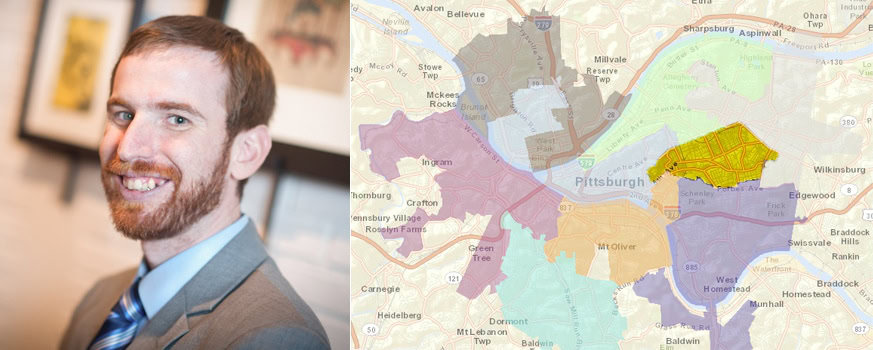Council District 8 Candidate, Dan Gilman Responds to 2013 BikePGH Questionnaire

Council District 8 Candidate: Dan Gilman
Twitter: @danielgilman
Facebook: facebook.com/dan.gilman.94
If you are not sure which Council District you are in, click here for the City of Pittsburgh’s interactive map.
1. Do you use a bicycle (or walk) in the city? If so, for what purposes (commuting, recreation, errands) and how often?
I walk regularly throughout the community. One of the reasons I love to live in the City is to be able to walk urban neighborhoods.
2. What roles do you think city council can play in making cities safe, accessible and friendly for biking and walking?
City Council has many important roles to play. First, if elected, I plan to introduce “complete streets legislation.” It is critical that all new development take biking and pedestrian safety into account equally with parking and care traffic. Additionally, Council can advocate for more bike lanes, signage, police training, and enforcement. It is critical that Council use the bully pulpit to advocate for critical changes. Lastly, I plan to introduce 21st century technology to city services. I hope to bring street paving to the streets that need it most and improve snow removal services. Our streets should not be an obstacle course of potholes for bicyclists.
3. In what ways can enhanced bicycling and walking facilities and opportunities benefit your district and the city as a whole? Are there any specific projects that you’d like to see accomplished?
The eighth district has a young and physically active population, many of whom commute to work nearby. With cuts to public transit, bicycling becomes more important for environment and budget minded constituents. As the East End sees explosive growth, we have many opportunities to incorporate biking into every project. The Penn Avenue bike path through Bakery Square 2 will be critical, as well the safety improvements to the Baum-Centre corridor. Many people choose to live in the east end because of the ability to walk/bike to the hospitals and universities. We must make this commute safer.
4. Pittsburgh was chosen to host the 2014 Pro Walk/Pro Bike Conference, which is expected to draw 1,000 biking and walking planners, engineers, government officials, and advocates from around the country, the largest gathering of it’s kind. Their focus is on biking and walking as means of getting around, with less focus on recreation. If you could put one project in place to “show off” your district, what would it be? Will you direct your staff to attend the conference to further their professional development?
I will personally attend the conference and bring my staff with me. In terms of one project to highlight the district, I would choose the Carnegie Mellon bike sharing program.
5. In just about every neighborhood throughout the city, one of the top concerns is drivers driving too fast, aggressively, and not yielding to pedestrians. What ideas do you have to calm traffic and make our neighborhoods safer and more comfortable in which to walk and bike? Feel free to talk about particular problem spots in your district.
Penn Avenue forms one of the borders of my district and is clearly a major safety hazard. Additionally, we need to make further improvements to Neville which is a priority given it is a primary route to the trail system. One of my major goals is to match police resources to specific council districts. This would include an increase in bike officers in District 8. Additionally, smarter traffic signalization would result in slower moving traffic since cars would not be rushing to make the next light. Lastly, as I previously stated, all new projects should be required to follow a complete streets plan.
6. Given Pittsburgh’s relatively low rate of car ownership and the recent transit cuts, what specific ideas do you have to make active transportation choices like biking and walking more appealing?
The key is safety. People need to feel safer using our major routes as a commuter. Too many of our main streets are too dangerous for many cyclists, which leaves them unwilling to use it as a primary transportation method. Additionally, bike parking and showering facilities need to be included in more projects and all public parking facilities.
7. What do you think is the number one risk to walkers and bicyclists both in your district and the city as a whole? What have you done/will you do as an elected official to remedy it?
Education. We need to educate motorists to share the road equally with cyclists/pedestrians. We need to change the mentality of drivers in this city to respect the rights and safety of cyclists/pedestrians.
8. What are your ideas for securing funding sources for biking and walking projects outside of the City’s Capital Budget?
Our city unfortunately sees a lot of waste due to use of outdated technology and a recalcitrant administration. However, with the changes I’d like to implement in city government, we stand to see higher productivity in government, and more attention paid to groups such as the burgeoning bicyclist population. Funding will follow as we are able to make services to bicyclists and pedestrians more of a priority. Lastly, there is national foundation money that exists for city’s willing to commit to proper planning.
9. In conclusion, why do you think people who care about bicycling and walking issues should vote for you?
I bring a new, youthful, innovative approach to city government. I am committed to urban living, smart growth, public transportation, and a New Pittsburgh. This means a city that recognizes that new residents and 21st century businesses want clean air, clean water, safe cycling routes, a strong parks system, and healthy living. Safe bike/pedestrian routes is at the heart of the new economy. I have the experience to know how city government works (after working for Bill Peduto for the past nine years) balanced with a new vision for a New Pittsburgh.
